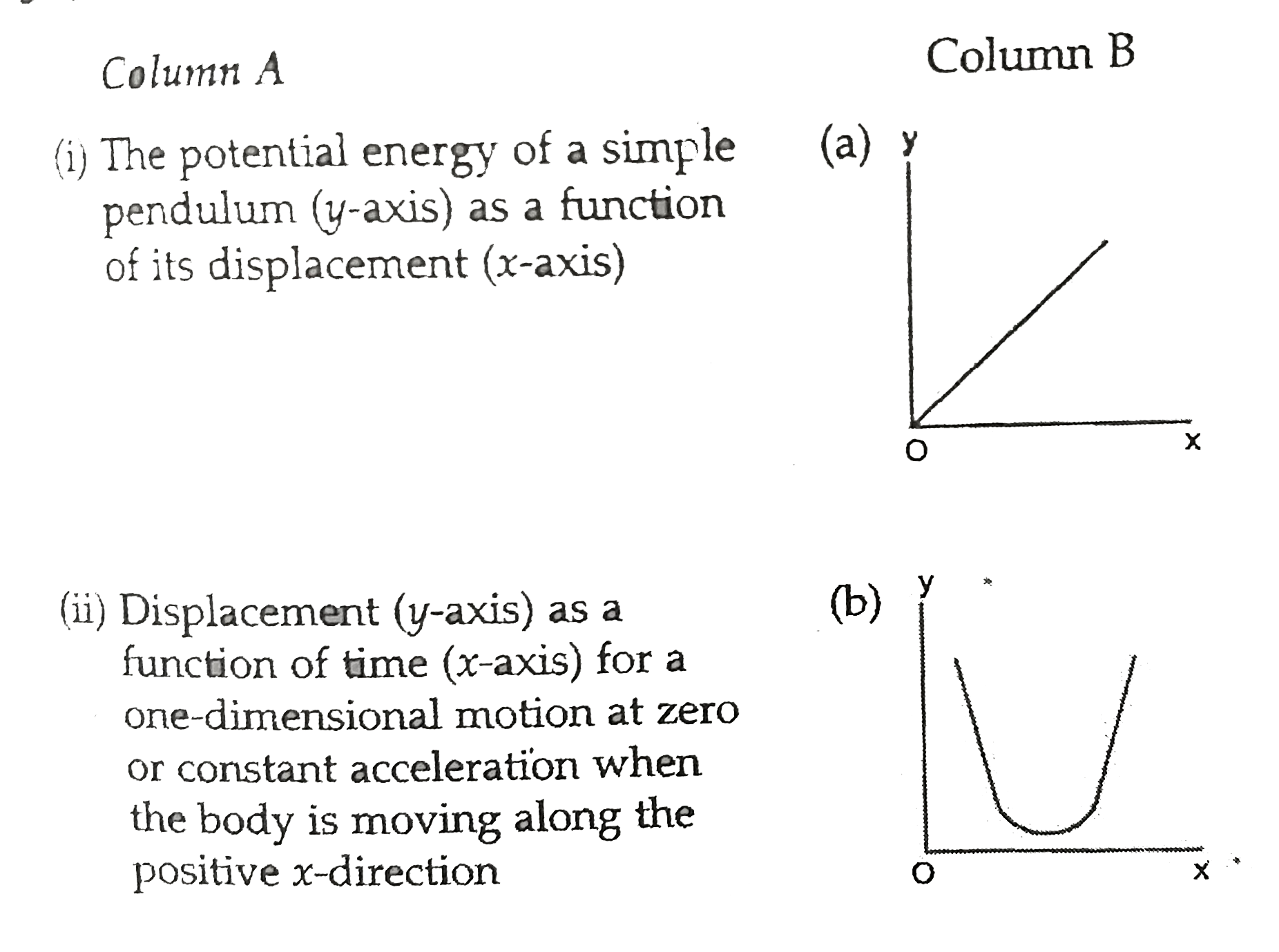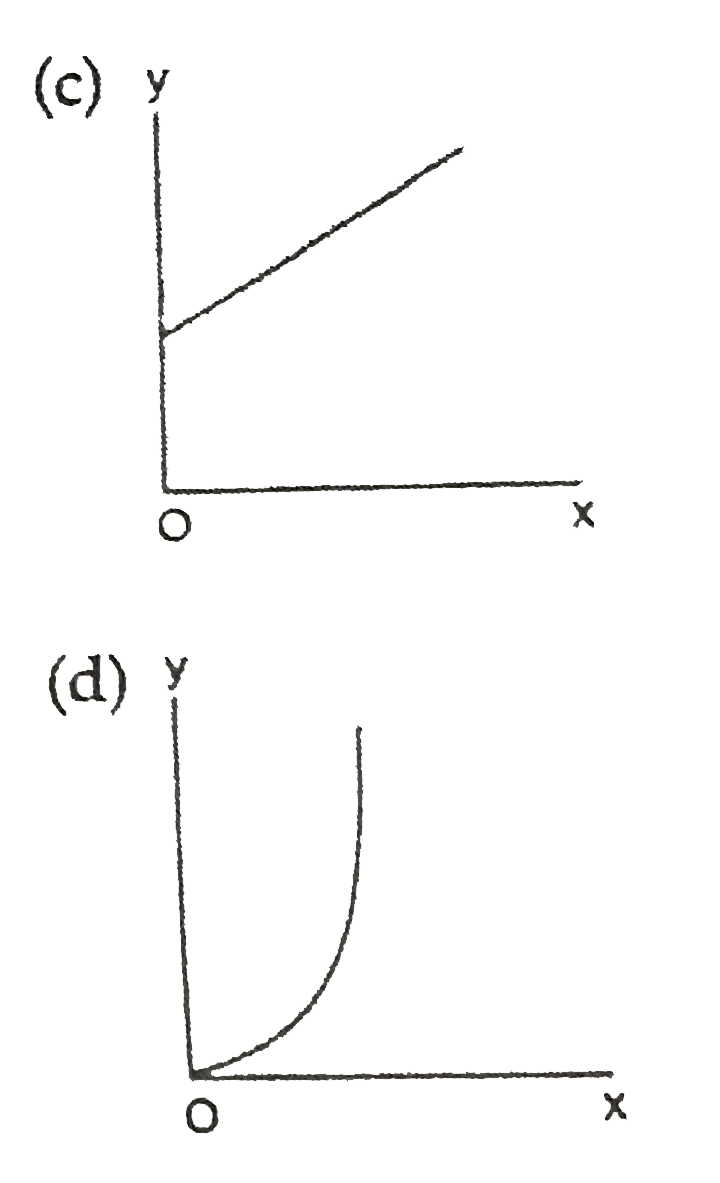Two discs A and B are mounted coaxially ona vertical axle. The discs have moments of inertia l and 2l respectively about the common axis. Disc A is imparted an initial angular velocity 2ω using the centre potential energy of a spring compressed by a distance x1. Disc B is imparted angular velocity ω by a spring having the same spring constant and compressed by a distance x2. Both the disc rotate in the clockwise direction.
The rotation x1/(x2 is.
2
12
√2
1√2
The correct Answer is:c
Step by step video, text & image solution for Two discs A and B are mounted coaxially ona vertical axle. The discs have moments of inertia l and 2l respectively about the common axis. Disc A is imparted an initial angular velocity 2 omega using the centre potential energy of a spring compressed by a distance x_(1). Disc B is imparted angular velocity omega by a spring having the same spring constant and compressed by a distance x_(2). Both the disc rotate in the clockwise direction. The rotation x_(1)//(x_(2) is. by Physics experts to help you in doubts & scoring excellent marks in Class 12 exams.
Updated on:21/07/2023Topper's Solved these Questions
- IIT QUESTIONS 1BOOK - D MUKHERJEECHAPTER - IIT QUESTIONS 1EXERCISE - Matrix-Matching Type
1 Video
- IIT QUESTIONS 1BOOK - D MUKHERJEECHAPTER - IIT QUESTIONS 1EXERCISE - Assertion- Reason Type
2 Videos
- HEAT AND THERMODYNAMICSBOOK - D MUKHERJEECHAPTER - HEAT AND THERMODYNAMICSEXERCISE - All Questions
85 Videos
- IIT QUESTIONS 2BOOK - D MUKHERJEECHAPTER - IIT QUESTIONS 2EXERCISE - Matrix matching type
1 Video
Similar Questions
Some physical quanties are given in Column I and some possible SI units in which these quantities may be expressed are given in Column II. Match the physical quantities in Column I with the units in Column II.
Column IColumn II(A)GMeMs(p)(volt)(coulomb)(metre)G−universal gravitational constantMe−mass of the earth,Ms−mass of the sun(B)3RTM(q)(kilogram)(metre)3(second)−2R−universal gas constant,T−absolute temperature, M- molar mass(C)F2q2B2(r)(metre)2(second)−2F−force,q−charge,B−magnetic field(D)GMeRe(s)(farad)(volt)2(kg)−1G−universal gravitational constant,Me−mass of the earth,Re−radius of the earth.
View SolutionSTATEMENT-l : In an elastic collision between two bodies, the relative speed of the bodies after collision is equal to the relative speed before the collision.
STATEMENT-2 : In an elastic collision, the linear momentum of the system is conserved.
View SolutionTwo holes of unequal diameters d1 and d2(d1>d2) are cut in metal sheet is heated

View SolutionColumn A gives a list of possible set of parameters measured in some experiments . The variations of the parameters in the form of graphs are shown in column B.


View SolutionTwo discs A and B are mounted coaxiallay on a vertical axle. The discs have moments of inertia I and 2 I respectively about the common axis. Disc A is imparted an initial angular velocity 2 omega using the entire potential energy of a spring compressed by a distance x_1 Disc B is imparted an angular velocity omega by a spring having the same spring constant and compressed by a distance x_2 Both the discs rotate in the clockwise direction. The ratio x_1//x_2 is
View SolutionTwo discs A and B are mounted coaxiallay on a vertical axle. The discs have moments of inertia I and 2 I respectively about the common axis. Disc A is imparted an initial angular velocity 2ω using the entire potential energy of a spring compressed by a distance x1 Disc B is imparted an angular velocity ω by a spring having the same spring constant and compressed by a distance x2 Both the discs rotate in the clockwise direction.
When disc B is brought in contact with disc A, they acquire a common angular velocity in time t. The average frictional torque on one disc by the other during this period is
View SolutionTwo discs A and B are mounted coaxiallay on a vertical axle. The discs have moments of inertia I and 2 I respectively about the common axis. Disc A is imparted an initial angular velocity 2 omega using the entire potential energy of a spring compressed by a distance x_1 Disc B is imparted an angular velocity omega by a spring having the same spring constant and compressed by a distance x_2 Both the discs rotate in the clockwise direction. The loss of kinetic energy in the above process is
View SolutionTwo discs A and B are mounted coaxially ona vertical axle. The discs have moments of inertia l and 2l respectively about the common axis. Disc A is imparted an initial angular velocity 2ω using the centre potential energy of a spring compressed by a distance x1. Disc B is imparted angular velocity ω by a spring having the same spring constant and compressed by a distance x2. Both the disc rotate in the clockwise direction.
The rotation x1/(x2 is.
View SolutionTwo discs A and B are mounted coaxially ona vertical axle. The discs have moments of inertia l and 2l respectively about the common axis. Disc A is imparted an initial angular velocity 2 omega using the centre potential energy of a spring compressed by a distance x_(1) . Disc B is imparted angular velocity omega by a spring having the same spring constant and compressed by a distance x_(2) . Both the disc rotate in the clockwise direction. When disc B is brought in contact with disc A , they acquirea common angularvelocity in time t . The average frictional torque on one disc by the other during this period is -
View SolutionTwo discs A and B are mounted coaxially ona vertical axle. The discs have moments of inertia l and 2l respectively about the common axis. Disc A is imparted an initial angular velocity 2 omega using the centre potential energy of a spring compressed by a distance x_(1) . Disc B is imparted angular velocity omega by a spring having the same spring constant and compressed by a distance x_(2) . Both the disc rotate in the clockwise direction. The loss of kinetic energy the above process is -
View SolutionTwo discs A and B are mounted coaxially on a vertical axle. The discs have moments of inertia I and 2I respectively about the common axis. Disc A is imparted an initial angular velocity 2ω using the entire potential energy of a spring compressed by a distance x1. Disc B is imparted an angular velocity ω by a spring having the same spring constant and compressed by a distance x2. Both the discs rotate in the clockwise direction.
A small object of uniform density rolls up a curved surface with an initial velocitiy v. It reaches upto a maximum height of 3v24g with respect to the initial position. The object is:
View Solutionदो डिस्कें A तथा B एक ऊर्ध्वाधर धुरी पर समाक्ष रूप से अवस्थिरत की गई है। उभयनिष्ठ अक्ष के परितः उन चकतियों के जड़त्व आघूर्ण क्रमशः I तथा 2I है। एक स्पि्रंग को x1 दूरी से दबाकर उसकी सम्पूर्ण स्थितिज ऊर्जा का उपयोग करके, चकती A को प्रारंभिक कोणीय वेग 2ω दिया जाता है। उतने ही स्पि्रंग गुणांक वाले एक दूसरे स्पि्रंग को x2 दूरी से दबाकर डिस्क B को कोणीय वेग ω दिया जाता है। दोनों चकतियां दक्षिणावर्त दिशा में घूम रही हैं
जब डिस्क B को डिस्क A के साथ सम्पर्क में लाया जाता है तो वे t समय में समान कोणीय वेग प्राप्त कर लेती है। इस अवधि में एक डिस्क पर दूसरी के द्वारा लगाया गया औसत घर्षण बल-आघूर्ण है।
View SolutionTwo discs A and B are mounted co-axially on a vertical axie. The discs have moments of inertia I and 2I , respectively, about the common axis. Disc A is imparted an initial angular velocity 2 omega using the entire potential energy of a spring compressed by a distance x_(1) . Disc B is imparted an angular velocity omega by a spring having the same spring constant and compressed by a distance x_(2) . Both the discs rotate in the clockwise direction. The ratio (x_(1))/(x_(2)) is
View SolutionTwo discs A and B are mounted co-axially on a vertical axie. The discs have moments of inertia I and 2I , respectively, about the common axis. Disc A is imparted an initial angular velocity 2 omega using the entire potential energy of a spring compressed by a distance x_(1) . Disc B is imparted an angular velocity omega by a spring having the same spring constant and compressed by a distance x_(2) . Both the discs rotate in the clockwise direction. When disc B is brought in contact with disc A, they acquire a common angular velocity in time t. The average frictional torque on one disc by the other during this period is
View SolutionTwo discs A and B are mounted co-axially on a vertical axie. The discs have moments of inertia I and 2I , respectively, about the common axis. Disc A is imparted an initial angular velocity 2ω using the entire potential energy of a spring compressed by a distance x1. Disc B is imparted an angular velocity ω by a spring having the same spring constant and compressed by a distance x2. Both the discs rotate in the clockwise direction.
The loss of kinetic energy during the above process is
View SolutionTwo discs A and B are mounted coaxially on a vertical axle. The discs have moments of inertia I and 2I respectively about the common axis. Disc A is imparted an initial angular velocity 2omega using the entire potential energy of a spring compressed by a distance x_(1) . Disc B is imparted an angular velocity omega by a spring having the same spring constant and compressed by a distance x_(2) . Both teh discs rotate in the clockwise direction. The ratio (x_(1))/(x_(2)) is :
View Solution

